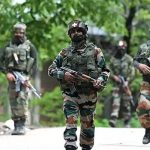In the chronicles of India’s counter-terrorism history, Operation Sindoor will be remembered not just as a military operation, but as a defining moment in the nation’s strategic journey—a national inflection point. In precision, planning, political resolve, and moral clarity, it marks a new era. More than a response, it was a strategic message. More than punishment, it was a doctrine in action. And above all, it was India’s Dharma Yudh—a Just War against terror.
We’ve seen bold actions before—Uri’s surgical strikes in 2016, and Balakot’s aerial precision in 2019—but Sindoor is not just a continuation. It’s a transformation. It reflects India’s evolution into a nation that no longer tolerates terror as the cost of statecraft but confronts it head-on—strategically, clinically, and unapologetically.
The Final Straw: When Tolerance Met Its Limit
India has endured the sting of terrorism for far too long. Decades of cross-border infiltration ambushes on soldiers, attacks on civilians, and proxy warfare launched from Pakistani soil have scarred our national psyche. Groups like Jaish-e-Mohammed (JeM), Hizbul Mujahideen (HM), and Lashkar-e-Taiba (LeT)—proscribed globally yet patronised openly in Pakistan—have treated Indian lives with impunity.
But the targeted killing of innocent tourists at Pahalgam, followed by irrefutable intelligence linking Pakistan-based terror masterminds to the act, proved to be the final trigger. No more dossiers. No more statements of condemnation. India responded—not impulsively, but with calibrated decisiveness. And thus, Operation Sindoor was born.
It wasn’t retaliation. It was an assertion—of sovereignty, of strategic clarity, and national will.
Breaking the Mould: Why Sindoor Was Different
1. From Strategic Restraint to Strategic Resolve
Perhaps the most significant shift was political. For decades, India bore the label of “strategic restraint”—a euphemism for tolerating provocation under fear of escalation. Sindoor shattered that illusion.
India invoked its right to self-defence under Article 51 of the UN Charter and struck deep—not just at terror camps, but at the entire ecosystem that nurtures them: ideological hubs, recruitment centres, logistics nodes, and command-and-control infrastructures.
The message was loud and irreversible: India will no longer absorb wounds quietly. It will respond in kind—and much more.
2. Tri-Service Coordination: Jointness in Action
In a first since the 1971 war, India’s Army, Air Force, and Navy operated in a theatre-level, trans-International Border (IB) operation. It wasn’t just a military campaign—it was a symphony of seamless jointness.
From kamikaze drones and precision air-to-surface missiles to electronic warfare (EW) strikes and cyber sabotage, India unleashed the full spectrum of modern warfare. In just 25 minutes, multiple high-value targets spread across Pakistan’s geography were neutralised.
The operation didn’t just display military might—it revealed a future-ready force backed by cutting-edge technology and razor-sharp coordination.
3. Targets that Hurt: Beyond LoC, Into Pakistan’s Terror Heartland
What made Operation Sindoor truly transformational was the boldness of its target selection. No longer were strikes confined to the Line of Control (LoC) or remote terrorist outposts.
This time, India went deep—Bahawalpur, the ideological HQ of JeM and Masood Azhar, was hit. Muridke, the operational hub of LeT under Hafiz Saeed’s network, saw critical infrastructure demolished. Even facilities linked to ISI’s strategic guidance of proxy warfare were struck with pinpoint accuracy.
This was not symbolic. This was strategic. India went for the jugular of Pakistan’s terror architecture. For the first time since 1971, we crossed the IB with full intent—boldly calling Pakistan’s nuclear bluff.
A Whole-of-Nation Approach: Military, Diplomatic, Economic, and Informational
Operation Sindoor wasn’t just a kinetic response. It was a coordinated application of all instruments of national power.
Diplomacy in Lockstep with Firepower
Even before the first strike, India’s envoys were already engaging global capitals. The messaging was crisp: India had acted in self-defence, within international law, and with moral justification. The diplomatic blitz pre-empted criticism and secured tacit, if not overt, international support. Even the United Nations Security Council (UNSC) stood inclined toward India’s position.
Economic Warfare: Dislocating Pakistan’s Psyche
Parallel to the strikes, India signalled the potential suspension of the Indus Waters Treaty—a critical artery for Pakistan’s agriculture-based economy. The psychological pressure this created was immense. For Pakistan, the cost of hosting terrorists was no longer just military—it was economic and existential.
Information Dominance: Controlled Escalation, Clear Narratives
India maintained informational superiority. The communication was tight, strategic, and focused. There was no jingoism, no war-mongering—only facts and resolve. The operation, despite its deep penetration, caused minimal civilian casualties or damage—a testament to India’s commitment to moral clarity and precision warfare.
Chanakya Niti in Execution: Time, Place, Intensity
India struck at a time of its choosing, in places of strategic sensitivity, and with an intensity that left no room for Pakistan’s miscalculation.
- Timing: Surprise was absolute. Rehearsals were conducted quietly. Assets were repositioned without alarm. Pakistan was caught flat-footed.
- Location: No longer limited to border skirmishes, India chose targets deep inside Pakistan’s heartland across LoC and IB—forcing Pakistan to defend terrain it never expected to.
- Intensity: Multiple redundant strikes ensured the destruction of high-value targets. There was no “Plan B” for Pakistan—only rubble.
Electronic warfare blinded Pakistani radars. Cyber-sabotage disrupted command networks. Pakistan’s defences never even saw the attack coming—and when they did, it was too late.
Pakistan’s Predicament: Bluff Called, Options Exhausted
For a nation that has long relied on nuclear blackmail and asymmetrical warfare, Operation Sindoor was a strategic nightmare.
1. The Credibility Crisis
Pakistan is caught in a trap of its own making. It cannot strike Indian civilians because India does not run terror camps. It cannot target military installations without risking all-out war. And with its economy on an IMF ventilator, sustained conflict is not an option.
2. No Strategic Depth
Pakistan’s narrow geography, vulnerable infrastructure, and internal instability make it uniquely exposed. Its urban sprawl, insurgency-infested west, and restive populations offer no cushion in case of escalation.
3. Nuclear Deterrence Neutralised
India has made it clear: the old rules don’t apply anymore. Any escalation will be met with massive retaliation. The so-called “tactical nuclear weapons” doctrine of Pakistan stands exposed and neutered. India’s no-first-use policy now includes first-response dominance.
World Response: Support, Silence, or Strategic Acceptance
Except for perfunctory statements from expected quarters like Turkey, the global community largely stood by India—or chose silence, which itself is an endorsement. Even China’s response was muted, calling merely for restraint.
The message was global: Pakistan must dismantle its terror infrastructure or face strategic isolation and strong military response.
The Dawn of a New Strategic Normal
Operation Sindoor is not just a military success—it’s a strategic doctrine in motion. It represents a unified India: politically resolute, militarily capable, technologically empowered, diplomatically persuasive, and morally clear.
This was not a war for vengeance—it was a Just War, waged in defence of sovereignty, dignity, and peace.
Terrorism is not just a security challenge—it’s a test of national character. India has shown that it will not be cowed, blackmailed, or bled quietly. It will strike back—hard, smart, and just.
In this Dharma Yudh, India did not fight out of hatred. It fought out of duty. And in doing so, it laid down a new strategic marker for the world. This is India 2025—with its eyes set on India 2047. Assertive, restrained, righteous—and ready.













